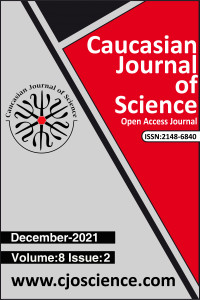Öz
Kaynakça
- Ammer, K.(2008). İnsan vücudunun termal görüntülerinin kaydedilmesi ve değerlendirilmesi için Glamorgan Protokolü. Thermal Int , 18 (4), 125-44.
- Amon, F. K., Bryner, N. P., & Hamins, A. (2005). Thermal imaging research needs for first responders: workshop proceedings. US Department of Commerce, Technology Administration, National Institute of Standards and Technology.
- Ayan, A., & Dönmez, S. (2018). Radyolojik Nükleer Kaza ve Terör Olaylarında Tıbbi Yönetim. Ankara Eğt. Arş. Hast. Dergisi, 51(2), 154-162.
- Barnes, R.B. (1963). Thermography of the Human Body: Infrared-radiant energy provides new concepts and instrumentation for medical diagnosis. Science, 140(3569), 870-877. Ekşi, A. (2016). Kbrn Terörizminde Risk Değerlendirmesi Ve Yönetimi, Journal of International Social Research, 9(42).
- Clark, W. G. (1979). Changes in body temperature after administration of amino acids, peptides, dopamine, neuroleptics and related agents, Neuroscience & Biobehavioral Reviews, 3(4), 179-231.
- Erkekoğlu, P., & Koçer-Gümüşel, B. (2018). Biyolojik Savaş Ajanları: Tarihçeleri, Patofizyolojileri, Tanıları, Tedavileri ve Önlemler. FABAD Journal of Pharmaceutical Sciences, 43(2), 81-111. Gade, R., & Moeslund, T.B. (2014). Thermal cameras and applications: a survey. Machine vision and applications, 25(1), 245-262.
- Ganesan, K., Raza, SK ve Vijayaraghavan, R. (2010). Kimyasal savaş ajanları. Eczacılık ve biyoallied bilimler dergisi, 2(3), 166
- Ivanescu, N.A., & Ciupitu, L. (2010, June). Vision system for human body infrared thermography. In 19th International Workshop on Robotics in Alpe-Adria-Danube Region (RAAD 2010) (pp. 353-356). IEEE.
- Jockers. D. (2014). Thermography: Is This The Best Breast Screening Device, https://drjockers.com/thermography-breast-screening/ .
- Uzun, N.K. (2007). Fever and feverly ill management. The Medical Bulletin of Sisli Etfal Hospital, 41(4), 7-13.
- Kılıç, S. (2006). Biyolojik silahlar ve biyoterörizm. Türk hijyen ve deneysel biyoloji dergisi, 63(1), 2.
- Lahiri, B.B., Bagavathiappan, S., Jayakumar, T., & Philip, J. (2012). Medical applications of infrared thermography: a review. Infrared Physics & Technology, 55(4), 221-235.
- Lee, F.F., Chen, F., & Liu, J. (2015). Infrared thermal imaging system on a mobile phone. Sensors, 15(5), 10166-10179
- Lock, A., & Amon, F. (2008). Measurement of the nonuniformity of first responder thermal imaging cameras. In Infrared Imaging Systems: Design, Analysis, Modeling, and Testing XIX (Vol. 6941, p. 694114). International Society for Optics and Photonics. Marsella, S., Sciarretta, N. (2018). CBRN Events and Mass Evacuation Planning, In Enhancing CBRNE Safety & Security: Proceedings of the SICC 2017 Conference (pp. 353-363). Springer, Cham.
- Nguyen, D.T., Kim, K.W., Hong, H.G., Koo, J.H., Kim, M. C., & Park, K.R. (2017). Gender recognition from human-body images using visible-light and thermal camera videos based on a convolutional neural network for image feature extraction. Sensors, 17(3), 637.
- Özcan, M., & Topçuoğlu, P. (2008). Akut Radyasyon Sendromu. Nükleer Kaza veya Terörist Atakta Hematopoietik Kök Hücre Transplantasyon.
- Prokoski, F. (2000). History, current status, and future of infrared identification. In Proceedings IEEE Workshop on Computer Vision Beyond the Visible Spectrum: Methods and Applications (Cat. No. PR00640) (pp. 5-14). IEEE.
- Richardt, A., Hülseweh, B., Niemeyer, B., & Sabath, F. (Eds.). (2013). CBRN protection: Managing the threat of chemical, biological, radioactive and nuclear weapons, Part 1. History and Treaties in CBRN- Warfare and Terrorism ( pp.2-8).
- Ring, E.F.J., McEvoy, H., Jung, A., Zuber, J., & Machin, G. (2010). New standards for devices used for the measurement of human body temperature. Journal of medical engineering & technology, 34(4), 249-253.
- Rodin, C. D., de Lima, L. N., de Alcantara Andrade, F. A., Haddad, D. B., Johansen, T. A., & Storvold, R. (2018). Object classification in thermal images using convolutional neural networks for search and rescue missions with unmanned aerial systems. In 2018 International Joint Conference on Neural Networks (IJCNN) (pp. 1-8). IEEE.
- Rudol, P., & Doherty, P. (2008). Human body detection and geolocalization for UAV search and rescue missions using color and thermal imagery. In 2008 IEEE aerospace conference (pp. 1-8).
- Sensoy, B., & Balci, H. (2004). Thermal imaging technology and applications in Turkey. In Proceedings of the IEEE 12th Signal Processing and Communications Applications Conference, 2004. (pp. 661-664). IEEE.
- Seyhan, E., & Sarı, G. (2012). Terör Maksatlı Biyolojik-Kimyasal Saldırılara Ait Tehdit Değerlendirmesinde Risk Analizi ve Yönetimi, Güvenlik Bilimleri Dergisi, 1(1), 79-94.
- Sillero-Quintana, M. (2015). Classification of factors influencing the use of infrared thermography in humans: A review. Infrared Physics & Technology, 71, 28-55.
- Singh, J., & Arora, A.S. (2020). Automated approaches for ROIs extraction in medical thermography: a review and future directions. Multimedia Tools and Applications, 79(21), 15273-15296.
- Speakman, J.R., & Ward, S. (1998). Infrared thermography: principles and applications. Zoology-Jena-, 101, 224-232.
- Shterenshis, M. (2017). Challenges to global implementation of infrared thermography technology: current perspective. Central Asian journal of global health, 6(1).
- T.C. İçişleri Bakanlığı Afet ve Acil Durum Yönetimi Başkanlığı(AFAD), (Ocak, 2021). KBRN Terimler Sözlüğü.
- Tkáčová, M., Hudák, R., Živčák, J., & Sidun, J. (2011, June). Thermographic atlas of the human body. In 2011 15th IEEE International Conference on Intelligent Engineering Systems (pp. 427-429). IEEE.
- Usamentiaga, R., Venegas, P., Guerediaga, J., Vega, L., Molleda, J., & Bulnes, F.G. (2014). Infrared thermography for temperature measurement and non-destructive testing. Sensors, 14(7), 12305-12348.
- Van Blyenburgh, P. (1999). UAVs: an overview. Air & Space Europe, 1(5-6), 43-47.
Thermal Camera Use for Evaluation of Patients and Injured in Chemical, Biological, Radiological, Nuclear Events
Öz
Chemical, Biological, Radiological, Nuclear (CBRN) areas contain various risks due to their structure. Chemical, biological, radiological, and nuclear threats can create separate or combined risks. For this reason, it is not possible to enter the scene safely without detecting the risks that may occur in a possible CBRN accident or disaster. Since the risk assessment in the incident area takes a long time, no team can enter the scene and find information and intervention until the risk assessment is done.
In this article, it is studied the determination of the general health status of people in hazardous CBRN zones via a thermal camera. It is obvious that there is a continuous need to obtain information about the scene of the incident such as the alive, sick, and injured people in the situation of hard-to-reach and highly hazardous CBRN areas. In addition, autonomous analysis techniques were studied on the obtained images.
In this study, it is focused on the determination of health status according to body temperature measurement, which is one of the vital signs, by the advantages of applying to more than one person without contact provided by thermal cameras integrated into a UAV. In addition, autonomous analysis techniques were studied on the obtained images. Within the scope of the study, a preliminary study was implemented on how thermal cameras can be used to evaluate vital signs in CBRN cases and to evaluate exposure levels according to body temperature.
Anahtar Kelimeler
Kaynakça
- Ammer, K.(2008). İnsan vücudunun termal görüntülerinin kaydedilmesi ve değerlendirilmesi için Glamorgan Protokolü. Thermal Int , 18 (4), 125-44.
- Amon, F. K., Bryner, N. P., & Hamins, A. (2005). Thermal imaging research needs for first responders: workshop proceedings. US Department of Commerce, Technology Administration, National Institute of Standards and Technology.
- Ayan, A., & Dönmez, S. (2018). Radyolojik Nükleer Kaza ve Terör Olaylarında Tıbbi Yönetim. Ankara Eğt. Arş. Hast. Dergisi, 51(2), 154-162.
- Barnes, R.B. (1963). Thermography of the Human Body: Infrared-radiant energy provides new concepts and instrumentation for medical diagnosis. Science, 140(3569), 870-877. Ekşi, A. (2016). Kbrn Terörizminde Risk Değerlendirmesi Ve Yönetimi, Journal of International Social Research, 9(42).
- Clark, W. G. (1979). Changes in body temperature after administration of amino acids, peptides, dopamine, neuroleptics and related agents, Neuroscience & Biobehavioral Reviews, 3(4), 179-231.
- Erkekoğlu, P., & Koçer-Gümüşel, B. (2018). Biyolojik Savaş Ajanları: Tarihçeleri, Patofizyolojileri, Tanıları, Tedavileri ve Önlemler. FABAD Journal of Pharmaceutical Sciences, 43(2), 81-111. Gade, R., & Moeslund, T.B. (2014). Thermal cameras and applications: a survey. Machine vision and applications, 25(1), 245-262.
- Ganesan, K., Raza, SK ve Vijayaraghavan, R. (2010). Kimyasal savaş ajanları. Eczacılık ve biyoallied bilimler dergisi, 2(3), 166
- Ivanescu, N.A., & Ciupitu, L. (2010, June). Vision system for human body infrared thermography. In 19th International Workshop on Robotics in Alpe-Adria-Danube Region (RAAD 2010) (pp. 353-356). IEEE.
- Jockers. D. (2014). Thermography: Is This The Best Breast Screening Device, https://drjockers.com/thermography-breast-screening/ .
- Uzun, N.K. (2007). Fever and feverly ill management. The Medical Bulletin of Sisli Etfal Hospital, 41(4), 7-13.
- Kılıç, S. (2006). Biyolojik silahlar ve biyoterörizm. Türk hijyen ve deneysel biyoloji dergisi, 63(1), 2.
- Lahiri, B.B., Bagavathiappan, S., Jayakumar, T., & Philip, J. (2012). Medical applications of infrared thermography: a review. Infrared Physics & Technology, 55(4), 221-235.
- Lee, F.F., Chen, F., & Liu, J. (2015). Infrared thermal imaging system on a mobile phone. Sensors, 15(5), 10166-10179
- Lock, A., & Amon, F. (2008). Measurement of the nonuniformity of first responder thermal imaging cameras. In Infrared Imaging Systems: Design, Analysis, Modeling, and Testing XIX (Vol. 6941, p. 694114). International Society for Optics and Photonics. Marsella, S., Sciarretta, N. (2018). CBRN Events and Mass Evacuation Planning, In Enhancing CBRNE Safety & Security: Proceedings of the SICC 2017 Conference (pp. 353-363). Springer, Cham.
- Nguyen, D.T., Kim, K.W., Hong, H.G., Koo, J.H., Kim, M. C., & Park, K.R. (2017). Gender recognition from human-body images using visible-light and thermal camera videos based on a convolutional neural network for image feature extraction. Sensors, 17(3), 637.
- Özcan, M., & Topçuoğlu, P. (2008). Akut Radyasyon Sendromu. Nükleer Kaza veya Terörist Atakta Hematopoietik Kök Hücre Transplantasyon.
- Prokoski, F. (2000). History, current status, and future of infrared identification. In Proceedings IEEE Workshop on Computer Vision Beyond the Visible Spectrum: Methods and Applications (Cat. No. PR00640) (pp. 5-14). IEEE.
- Richardt, A., Hülseweh, B., Niemeyer, B., & Sabath, F. (Eds.). (2013). CBRN protection: Managing the threat of chemical, biological, radioactive and nuclear weapons, Part 1. History and Treaties in CBRN- Warfare and Terrorism ( pp.2-8).
- Ring, E.F.J., McEvoy, H., Jung, A., Zuber, J., & Machin, G. (2010). New standards for devices used for the measurement of human body temperature. Journal of medical engineering & technology, 34(4), 249-253.
- Rodin, C. D., de Lima, L. N., de Alcantara Andrade, F. A., Haddad, D. B., Johansen, T. A., & Storvold, R. (2018). Object classification in thermal images using convolutional neural networks for search and rescue missions with unmanned aerial systems. In 2018 International Joint Conference on Neural Networks (IJCNN) (pp. 1-8). IEEE.
- Rudol, P., & Doherty, P. (2008). Human body detection and geolocalization for UAV search and rescue missions using color and thermal imagery. In 2008 IEEE aerospace conference (pp. 1-8).
- Sensoy, B., & Balci, H. (2004). Thermal imaging technology and applications in Turkey. In Proceedings of the IEEE 12th Signal Processing and Communications Applications Conference, 2004. (pp. 661-664). IEEE.
- Seyhan, E., & Sarı, G. (2012). Terör Maksatlı Biyolojik-Kimyasal Saldırılara Ait Tehdit Değerlendirmesinde Risk Analizi ve Yönetimi, Güvenlik Bilimleri Dergisi, 1(1), 79-94.
- Sillero-Quintana, M. (2015). Classification of factors influencing the use of infrared thermography in humans: A review. Infrared Physics & Technology, 71, 28-55.
- Singh, J., & Arora, A.S. (2020). Automated approaches for ROIs extraction in medical thermography: a review and future directions. Multimedia Tools and Applications, 79(21), 15273-15296.
- Speakman, J.R., & Ward, S. (1998). Infrared thermography: principles and applications. Zoology-Jena-, 101, 224-232.
- Shterenshis, M. (2017). Challenges to global implementation of infrared thermography technology: current perspective. Central Asian journal of global health, 6(1).
- T.C. İçişleri Bakanlığı Afet ve Acil Durum Yönetimi Başkanlığı(AFAD), (Ocak, 2021). KBRN Terimler Sözlüğü.
- Tkáčová, M., Hudák, R., Živčák, J., & Sidun, J. (2011, June). Thermographic atlas of the human body. In 2011 15th IEEE International Conference on Intelligent Engineering Systems (pp. 427-429). IEEE.
- Usamentiaga, R., Venegas, P., Guerediaga, J., Vega, L., Molleda, J., & Bulnes, F.G. (2014). Infrared thermography for temperature measurement and non-destructive testing. Sensors, 14(7), 12305-12348.
- Van Blyenburgh, P. (1999). UAVs: an overview. Air & Space Europe, 1(5-6), 43-47.
Ayrıntılar
| Birincil Dil | İngilizce |
|---|---|
| Konular | Çevre Bilimleri |
| Bölüm | Caucasian Journal of Science |
| Yazarlar | |
| Yayımlanma Tarihi | 31 Aralık 2021 |
| Gönderilme Tarihi | 8 Aralık 2021 |
| Kabul Tarihi | 29 Aralık 2021 |
| Yayımlandığı Sayı | Yıl 2021 Cilt: 8 Sayı: 2 |








